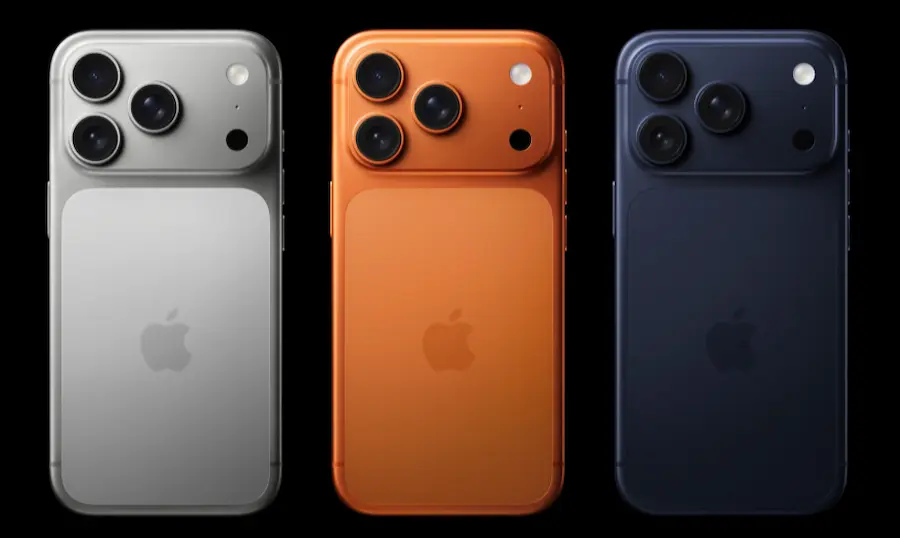The showdown was inevitable: iPhone 17 Pro Max versus the 16 Pro Max and 15 Pro Max, focusing on what we like most at ActualApp — the camera. Is there really a noticeable leap in everyday use or is it more a change aimed at very specific profiles? We’ll dissect it closely and, above all, without the hype. As you know, we have been comparing these models with their direct rivals.
What they share: a solid foundation for creators
Before diving into differences, there’s a common base that’s already very powerful: all three models mount a triple camera with ultra wide, wide and telephoto, so versatility is guaranteed for photo and video. In addition, all include a USB-C port with speeds up to 10 Gb/s, which provides a key advantage for serious workflows: recording directly to an external SSD using that port, a practice increasingly common when you want to avoid internal storage limits or speed up subsequent editing.
Another important commonality is Apple ProRAW for photography. Note, we’re talking about photos, not video; this detail often causes confusion. ProRAW gives you room to recover highlights and shadows and adjust color more freely, like when you move from JPEG to RAW on a mirrorless camera, and you notice that extra “cushion” to push the digital developing.
Photo: more megapixels where it matters
In photography, the evolution is incremental. The iPhone 15 Pro Max starts with a 48 MP main sensor, while the ultra wide and the telephoto stay at 12 MP. With the iPhone 16 Pro Max, Apple strengthens the set: both the main sensor and the ultra wide rise to 48 MP, leaving the telephoto at 12 MP. The big jump comes with the iPhone 17 Pro Max, which evens out the trio with 48 MP on all three cameras.
What does this imply in practice? More detail and more cropping margin at all focal lengths, so you can reframe without penalizing sharpness as much — especially useful in landscapes with the ultra wide or when isolating subjects with the telephoto. In fact, having 48 MP on all three optics makes the experience more consistent, since the level of detail doesn’t “change” when you switch between cameras. If your main use is photography, you’ll notice the jump from the 15 to the 16 and, above all, the consolidation in the 17.

Video: 4K120, ProRes RAW, Log2 and OpenGate
The big revolution, however, comes in video. The iPhone 15 Pro Max records up to 4K at 60 fps and offers Apple ProRes alongside Apple Log, a solid combo for serious productions. The iPhone 16 Pro Max matches the formats but raises the frame rate to 4K at 120 fps, opening the door to high-quality slow motion without sacrificing resolution.
With the iPhone 17 Pro Max the approach changes: it keeps 4K at 120 fps, but replaces ProRes with ProRes RAW for video, introduces Apple Log 2 and adds OpenGate capture. Why is this relevant? ProRes RAW preserves “raw” sensor information, which gives more freedom to adjust exposure and balance in editing — an ideal scenario if you work color in DaVinci Resolve or Final Cut Pro and want to squeeze every take. Apple Log 2, for its part, expands the usable range for grading, with a more flexible profile to lift shadows or tame highlights.
OpenGate lets you use a larger capture area, useful for reframing and different aspect ratios without sacrificing field of view, something highly appreciated in “shoot once, deliver in multiple formats” workflows. Together, these are features that smell like cinema and recall what we see in professional cameras when you want creative margin in postproduction.
Also, being able to offload those signals to an external SSD at 10 Gb/s over USB-C means fewer bottlenecks and a more direct pipeline: you record, unplug and take the drive to the editing suite. If you move heavy clips, this combination is pure gold.
Is it worth upgrading?
The decision depends on your profile. If you come from the iPhone 15 Pro Max and video is your priority, the jump is clear: going from 4K60 to 4K120 is already significant, and on the 17 Pro Max the bet on ProRes RAW, Log 2 and OpenGate adds professional-level tools for those who squeeze postproduction. If your focus is more photographic, there are improvements too: from the 15 to the 16 the ultra wide steps up, and the 17 completes the set with 48 MP on all three cameras for full coherence.
From the iPhone 16 Pro Max, the change to the 17 Pro Max is more nuanced if you’re not going to take advantage of the new video formats; you keep 4K120, but without ProRes RAW, Log 2 or OpenGate, so the difference becomes evident only if you work heavily with color and editing. In short, do you want a phone that behaves more and more like a pocket cinema camera and to gain headroom in post? Then the 17 Pro Max makes sense. If not, the 16 Pro Max is still a very solid choice and the 15 Pro Max continues to perform excellently for most users.
The good news is that, whichever you choose, the base is very pro: versatile triple camera, ProRAW in photo and direct recording to an SSD via USB-C at 10 Gb/s. The big question is how much you’ll take advantage of that arsenal. Ready to take your workflow to the next level?


